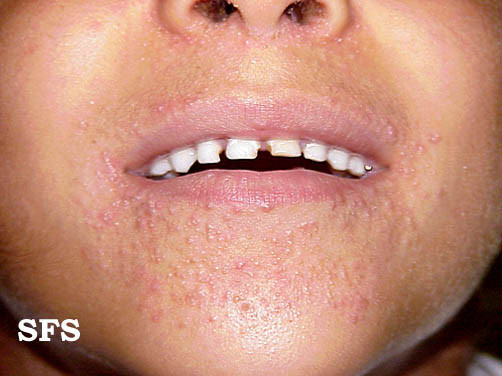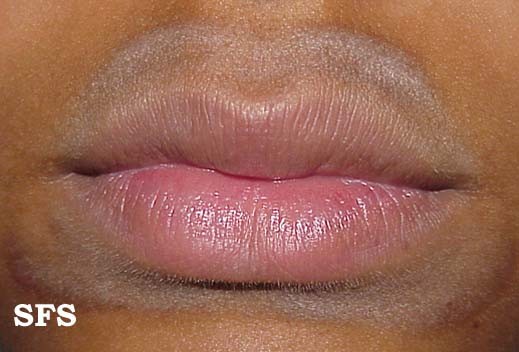Rash Around Mouth (Lips) Causes, Pictures, Treatment
The skin on the lips is much thinner than elsewhere on the body. It also lacks much of the natural moisturizing ability because there are no sebaceous glands on it. Furthermore it lacks the skin pigment, melanin, which provides protection against ultraviolet (UV) light. So it is understandable that a rash can occur on the lips from physical injury, dryness and with intense sunlight exposure. Sometimes this rash may extend on to the lip surface but there are certain types of rash around the mouth that only affects the skin and does not usually involve the lips itself.
What is perioral dermatitis?
Perioral dermatitis is the medical term for a rash around the mouth, bordering the lips but usually not involving the lips. The term perioral dermatitis literally means inflammation of the skin (dermatitis) around the mouth (perioral). Although there are many skin conditions that can affect this area and cause skin inflammation, the term perioral dermatitis usually refers to a specific skin disorder.
It is a chronic condition where there is pronounced redness in the affected area that resembles rosacea. The exact cause is unknown but the condition has been associated with long term use of steroid creams. This may not be the cause of perioral dermatitis but rather the trigger of the condition.
Perioral dermatitis affects about 1 in 100 people in the United States. The condition is often seen among women between the age of 20 to 45 years old. Men and children are very rarely affected. However, a skin rash around the mouth can be due to so many conditions, like contact dermatitis, which often affects babies and children.
Causes of Rash Around the Mouth
For the purpose of this article, contact dermatitis around the mouth and perioral dermatitis are discussed in greater detail. However, it is important to know that many other skin conditions could also cause a rash around the mouth.
Contact Dermatitis Around the Lips
Contact dermatitis simply means skin inflammation that occurs when some substances makes contact with the skin. There are two types of contact dermatitis. The first is irritant contact dermatitis which occurs when some substance irritates the skin. The second is allergic contact dermatitis where some harmless substances triggers an allergic reaction at the area where it makes contact with the skin. The dermatitis can affect the lips as well.
Common irritants relevant to the mouth include:
- Saliva – rashes are common in babies due to drooling
- Lipstick, lip liner or lip gloss and other makeup
- Hair removal – shaving, waxing and depilatory creams
- Shaving foam, aftershave
- Soap and cleansers
- Toothpaste or mouthwash
- Water and sweat (prolonged contact with the skin)
- Certain foods and beverages (if skin not wiped or washed after consumption)
- Repeated wiping, rubbing or scratching of the area
Causes of Perioral Dermatitis
There is some degree of overlap between the causes of contact dermatitis and perioral dermatitis. The symptoms are also similar. Contact dermatitis is largely an acute condition that occurs when irritants or allergens make contact with the skin. Perioral dermatitis is often a chronic facial skin condition. Typically a small border around the lips of about 5 to 10 millimeters remains unaffected and may appear white in color.
Although the exact cause of perioral dermatitis is unknown, it appears to be due to increased skin sensitivity to various stimuli possibly associated with the long term use of corticosteroid creams. It is not conclusively known whether steroid use is the cause or trigger but it often precedes the onset of perioral dermatitis. There may also be a history of abusing steroid creams. Skin lighteners containing corticosteroids may also be a problem.
Triggers of perioral dermatitis includes:
- Corticosteroids: topical as ointments or creams, and even with steroid inhalers or nasal sprays
- Fluoridated toothpaste
- Climate conditions including sun and wind exposure
- Fungi and bacteria (perioral dermatitis is not a skin infection)
- Hormones – premenstrual or oral contraceptive pills
- Makeup and other cosmetics
Other Causes
- Acne vulgaris
- Rosacea
- Folliculitis
- Tinea faciei / tinea barbae (fungal)
- Herpes simplex virus (HSV)
- Psoriasis
- Atopic dermatitis
- Sunburn
Pictures of Rash Around the Mouth
The following images show both contact dermatitis of the lips (picture 1) and perioral dermatitis (pictures 2 and 3).

Pictures of perioral dermatitis
Treatment of Rash Around the Mouth
It is important that the exact type of rash is diagnosed by a doctor as the treatment can vary to some extent. For both contact dermatitis and perioral dermatitis, all topical applications should be stopped immediately. With contact dermatitis this may be sufficient for the rash to resolves quickly without any medical treatment. However, in perioral dermatitis the rash may sometimes continue even with discontinuing all creams, cosmetics and even soaps.
Contact dermatitis is only treated when the symptoms are severe and not resolving with conservative measures. Corticosteroid creams may be prescribed for use on the skin. However, these creams should be avoided entirely in perioral dermatitis and there is often a history of abusing these creams. In severe cases of contact dermatitis oral corticosteroids may be considered for short term use until the symptoms ease.
Perioral dermatitis is treated with antibiotics when the condition does not resolve with stopping all skin applications. A substance known as pimecrolimus may also be prescribed and this is also sometimes used in contact dermatitis. Isotretinoin, a drug that is more often used for acne, may also be prescribed for severe cases of perioral dermatitis but only when other measures have failed.
It is important for perioral dermatitis sufferers to be aware that the condition can last for months or years without treatment. Even after the dermatitis subsides, skin applications may need to continue being avoided for an indefinite period of time. Sometimes what seems like extreme measures may need to be implemented like avoiding fluoridated toothpaste. It is important to follow a doctor’s advice closely when it comes to the treatment of perioral dermatitis.
Scratching, pinching or picking the area can lead to secondary bacterial infections in both contact dermatitis and perioral dermatitis. It is therefore important that these actions be avoided and the hands be kept clean as much as possible in the even of unconscious touching of the affected area.
References
- Red Rash Around Mouth. American Association of Dermatology
- Periorificial Dermatitis. Dermnet NZ







